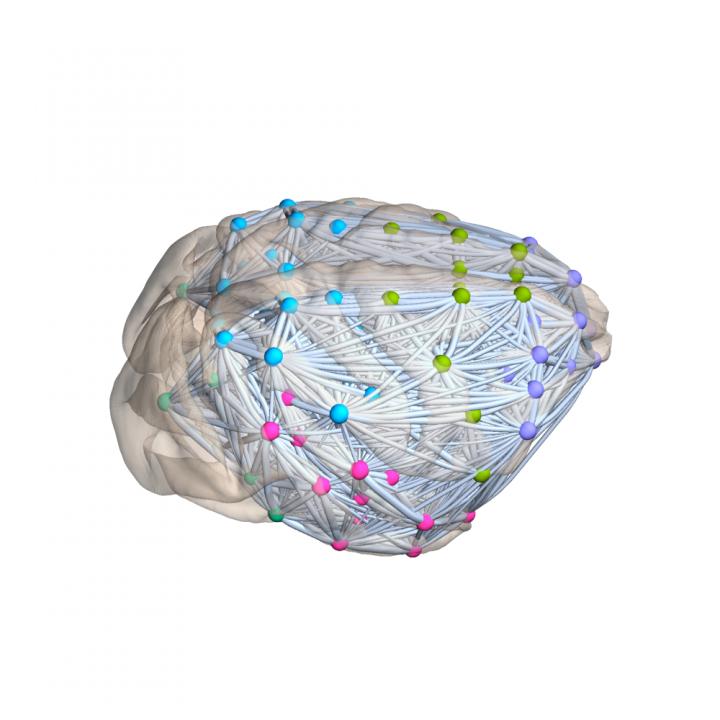Presentations at the 2020 APS March Meeting will cover the effects of mammalian brain size on connectivity networks, where the cerebellum gets its folds, and how the brain responds to music

Credit: Sz. Horvat (Center for Systems Biology, Dresden), F. Molnar and Z. Toroczkai (Univ. Notre Dame)
DENVER, COLO., FEBRUARY 28, 2020 — Understanding the brain has been one of science’s greatest challenges. Each discovery only seems to raise countless other questions about the inner workings of this incredibly complex organ. Brain research brings together disciplines like neuroscience, medicine, biochemistry, and even physics. At the 2020 American Physical Society March Meeting in Denver, scientists will present their latest research on the physics of the brain.
Mapping the Mammalian Connectome
University of Notre Dame researcher Zoltan Toroczkai will describe his work on mapping the physical connections between different areas of the brain. In particular, he is interested in which brain networks have been evolutionarily conserved across mammalian species, including our own.
“Our goal is to understand how the brain works, and for this, we need to understand how the brain is connected,” said Toroczkai, a professor of physics, computer science, and engineering. “With this connectivity data, we want to look for any regularity in how the brain is wired.”
Despite huge variations in the brain sizes of mammals, he and his collaborators have discovered that the organization of the brain follows a principle called the Exponential Distance Rule. It states that the wiring probability between two cortical areas decreases exponentially the further away they get from one another.
Shaping the Little Brain
Despite its small size, the human cerebellum–Latin for “little brain”–contains more neurons than the rest of the brain. It manages our body’s muscle coordination and sense of balance. Like the cerebrum, it has two hemispheres, lobes that branch into smaller lobes, and intricate surface folds that form during the early stages of growth.
Jennifer Schwarz, a physicist at Syracuse University, investigates how the cerebellum gets its convoluted shape. She will report on a new “buckling without bending” model that predicts the formation of its intricate folds, lobes, and other morphological features.
Schwarz’s model consists of a rigid core of cells surrounded by a fluid-like cortical layer of dividing cells. Shape change occurs as a result of mechanical constraints on the outer cortical layer as it continues to grow. The findings have possible implications for brain folding-related diseases, and additional applications for shape development in other parts of the body like the retina.
How Music Heals the Brain
Our brains respond to music in different ways. That may explain why music therapy works for some patients and not others, suggests new research by Rice University’s Melia Bonomo, a PhD candidate in applied physics.
Bonomo and her colleagues scanned the brains of healthy people while they listened to their favorite song, familiar and unfamiliar music, and speech recordings. They found individual differences in whole-brain connection patterns and co-activation of regions responsible for autobiographical memory, prospection, and processing emotion.
As a next step, she wants to investigate whether these neural activity patterns could be used to find auditory stimuli that could successfully boost music therapy outcomes.
“In the short term, we’re applying the results to a clinical trial that we’ve just started to test the mental health benefits of participating in a six-week creative music course for patients with mild cognitive impairment,” she said.
###
Architectural Principles and Predictive Modeling of the Mammalian Connectome
TIME/DATE/PLACE: 3:18 PM, Wednesday, March 4, 2020, Room: 304
CONTACT: Zoltan Toroczkai, [email protected]
Hierarchical “Buckling without Bending” and Brain Shape
TIME/DATE/PLACE: 1:27 PM, Friday, March 6, 2020, Room: 304
CONTACT: Jennifer Schwarz, [email protected]
Modularity Allows Classification of Human Brain Networks during Music and Speech Perception
TIME/DATE/PLACE: 8:48 AM, Wednesday, March 4, 2020, Room: 304
CONTACT: Melia Bonomo, [email protected]
ABOUT THE MEETING
The American Physical Society (APS) March Meeting is a major international conference and the largest physics meeting of the year. In 2020, the APS March Meeting will convene from March 2-6 at the Colorado Convention Center in downtown Denver.
Useful Links
Meeting website: https:/
Scientific program: http://meetings.aps.org/Meeting/MAR20/APS_epitome
Press services: https:/
Hotel & Travel information: https:/
Press Registration
Complimentary registration is available to journalists for the express purpose of gathering and reporting news and information from the meeting. Staff reporters, freelance writers, and students are welcome to apply. Press credentials may be obtained by completing the form on this page: https:/
Press Conferences
All press conferences will take place in Room 608. If you are unable to attend, you may register to watch and ask questions online at https:/
Press Room
A press room for registered journalists will operate throughout the meeting in Room 610/612 and will offer complimentary coffee, breakfast, and lunch. The press room may be reserved for conducting interviews.
Hours
Monday – Thursday, 7:30 a.m. – 6:00 p.m.
Friday, 7:30 a.m. – 2:45 p.m.
Please contact the APS Press Office with any questions at [email protected].
ABOUT APS
The American Physical Society is a nonprofit membership organization working to advance and diffuse the knowledge of physics through its outstanding research journals, scientific meetings, and education, outreach, advocacy, and international activities. APS represents over 55,000 members, including physicists in academia, national laboratories, and industry in the United States and throughout the world. Society offices are located in College Park, Maryland (Headquarters), Ridge, New York, and Washington, D.C.
Media Contact
APS Press Office
[email protected]
301-209-3090




